Caricatures of Dua Lipa rolling her tongue out, a Himalayan langur representing a coffee liqueur, a space astronaut floating on a label to a graphic novel that takes you on a whimsical adventure across the Universe for agave can influence your choice of drink. Anything is possible, with spirit makers eager to give you a taste of their artistic expression as a communication tool to swirl you into an engaging interaction with their liquid even before you take the first sip. Take an art tour to find out how:
Crowd-funding a label
In 2018, Rohan Rehani and Nitin Vishwas dispatched Moonshine’s first mead lot to Mumbai. From the start, they treated their labels as conversation starters.
In 2021, Nikhil More from Junglegym, was brought on board to rebrand Moonshine. “Post the re-branding exercise came the packaging. We created a label template for them, wherein artists from around India would be invited to design the label within the given framework. This needed a flexible design system, because we had to balance between ensuring that the brand name "Moonshine has that recall for the customer, while at the same time, each one should look drastically different from the other variants,” says More, whose work has also featured on the traditional mead label. A black and white minimalist rendition paying homage to "Aryabhata" India's first satellite.
“In the lockdown, we crowd-sourced our label for grilled pineapple mead. We received 1,000 entries. An internal and external judging panel chose the winning designs that were remunerated as per industry standard,” says Rehani.
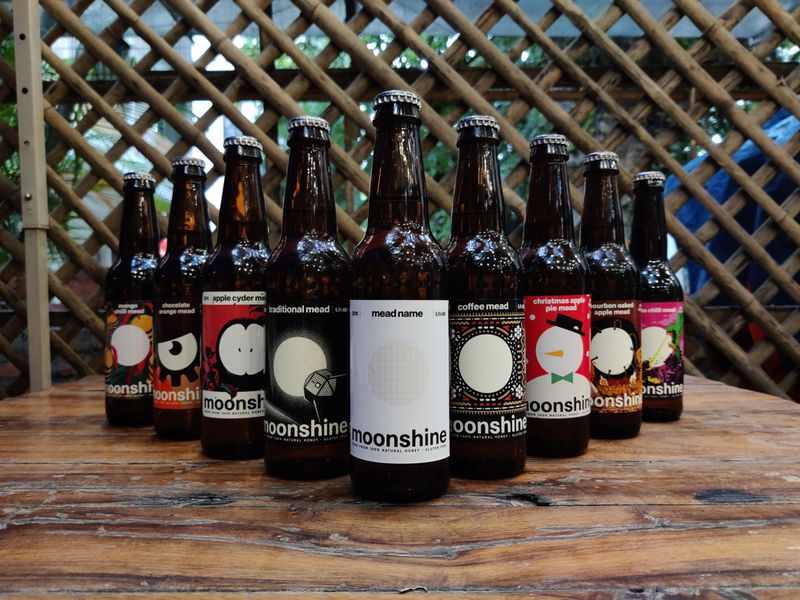
They did a second round of crowdsourcing for Hibiscus ginger flavour in June 2022. “Good packaging graphics helps alcohol and beverage brands connect with the consumer because they don't get to try the product before they buy it. For example, people who don't understand wine and are looking to give it a try will pick up the bottle that speaks to them at a visual level. Globally, we are seeing trends where there is only artwork with no brand name on the front label - that gives the consumer an irresistible urge to pick the bottle up and know more - it's human nature. Majority of Indian audiences are not ready for this radical approach and nor is our excise department so we are a while away from such design. But given some of the recent changes in excise laws in the state of Maharashtra and India, I can safely say that it's an exciting time to be an artist or designer today as the opportunities are ripe with regards to the alco-bev scene," says More.
AlsoRead0
It took a few sips for 28-year-old Niharika Kapil to visualise what the lemon tea mead would look like. “I started by sipping the mead to understand the flavours. My brief was simple, that it should be bold, fresh and the main ingredients should be the star. The flavours helped me visualise the mood and colours. I got the bottle to envisage the composition and ratios of the elements and after multiply explorations, the final artwork emerged. While I have done packaging elements before, this was my first-time using bottle label as a canvas,” shares Kapil.
A Gond artist and a mahua tree
For Mohulo - a mahua spirit made by a Self-Help Group (SHG) of Gond tribal women, in Bhaka Mal of Dindori district in Madhya Pradesh - Anju Arunkumar, former CEO Zila Parishad, Dindori, suggested the logo to be a mahua tree with its rounded leaves and its unique grape-shaped yellow flowers. It took Gond artist, Sunil Shyam Moti in Patangarh, (which holds the GI tag for Gond art), three renditions to perfect the vision.
Aniruddha Mookerjee, advisor to the Madhya Pradesh government’s initiative to commercially distil and bottle mahua, an indigenous liquor consumed in at least 13-14 Indian states, says, “Sunil made a larger version on an A4 sheet, and the first attempt looked more like a ficus tree. We thus worked with him to bring out a stylised mahua tree and worked along with Anju’s successor, Nanda Bhalawe, who is also an artist, with various fonts, type sets and label sizes to fit the informative copy, ensuring it was legible.”
It was important to get the art right as it had to look attractive enough for first-time urban consumers to notice it on the shelves and try it. “Not everyone gets to see how it is made, so art holds a communicative value for us. We wanted to create the right associations in the consumer’s mind, something indigenous to match up with our indigenous spirit,” he sums up the six-month-long effort.
Pave way for Maya
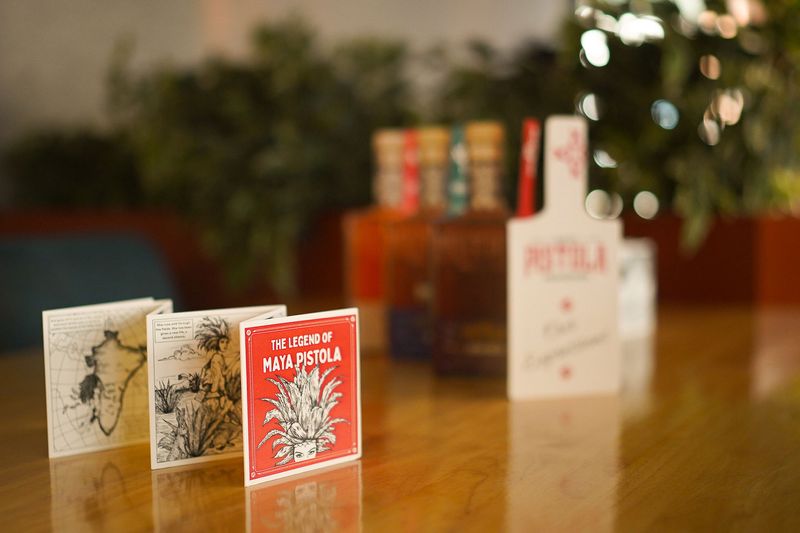
It’s an odd hour when we get on a Zoom call with graphic designer Tanya Sigga in Canada. But she’s chirpy to talk to us about Maya, the character with a tuft of rosette of agave leaves, who leads the Pistola brand story. “I am passionate about storytelling through comics,” Sigga tells us, who put on her research mode for all things agave spirit in 2021, when Pistola approached her for character creation and the illustration for their promotional graphic novel.
“The brief revolved around the story of a character called Mayahuel and her story of how she became Maya Pistola. The story begins with Maya being imprisoned in a lonely corner of the universe by her evil grandmother, the Goddess of Darkness. The God of Wind rescues her from outer space and begins a goose chase with the grandmother in tow. When she strikes Maya with lightning, he brings her remains to the Deccan plateau where he plants her. Only to witness the rise of Maya Pistola. The approach was interesting, storytelling through Aztec mythology, Indian elements and craft agave spirit. An artist always begins with visual research of what is already out there. I found nothing. We began building from scratch. We didn't know what the characters would look like,” says Sigga. The story was already split into nine frames which creates a map and shows the character land in the Deccan Plateau.

“I picked up elements from Aztec art, referring to tattoos and symbolism. I always need to justify why there are certain elements in my art. Why should the God of Wind, who is a serpent dragon in human form, have feathers on his head and feet? Why does he have a nose piercing? They have a symbolic meaning in the mythology,” says Sigga, confessing that the entire project is rendered in line drawing. “My wrist was just gone by the end of it,” Sigga quips.
The art on the bottle had to fit in the compact space and still make an impact. “The agency came up with the typography and design first. Then the trick was to place Maya in the back of the bottle. We have her head coming out of the ground for impact,” Sigga signs off.
Night falls on a whisky to reflect its peaty notes
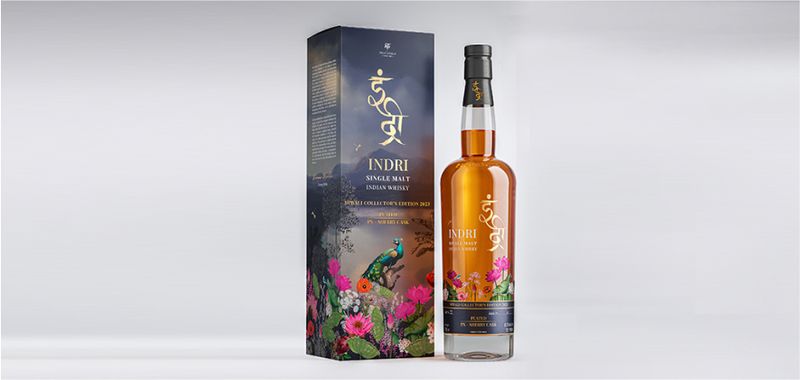
Last year, award-winning multidisciplinary artist Krsna Mehta designed Indri’s Diwali Collector’s Edition 2023 single malt made with six-row barley, distilled in traditional copper pot stills. Taking notes of the peaty whisky into account Mehta worked on a nightfall backdrop, filling it with poppies, peacocks, lotuses and all symbolic elements that reflect Indian beauty and nature. “My style seeks Indian inspirations and then contemporises it. Since it was a peated expression, the night sky connects the design with the nature of the liquid,” says Mehta.
Talking about the process, he says one has to understand the brand ethos, and what they trying to communicate. “It’s never my way or the highway. I listen to what the client says, take feedback because they know their customer best,” says Mehta.
Swirl of a peg in a couch
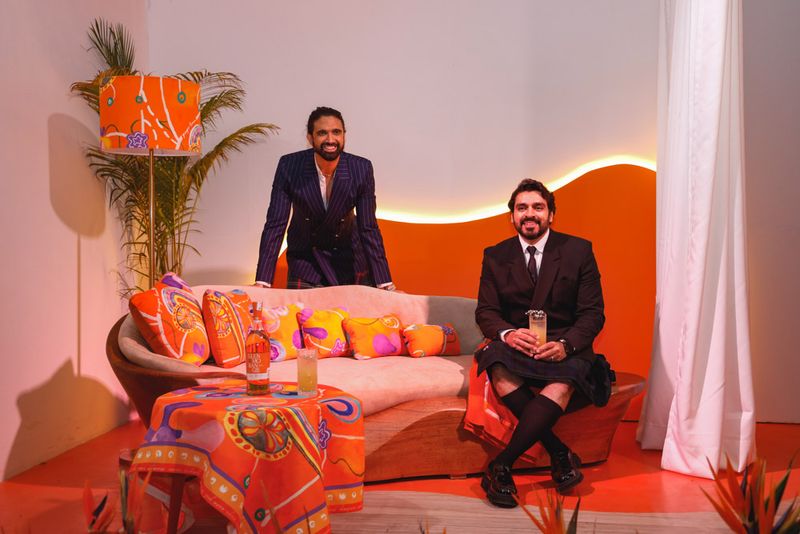
Then there are times when art helps the characteristics of a spirit step out of the box. Recently, designers Shivan Bhatiya and Narresh Kukreja designed Delicious Living—a limited edition collection of artisanal couches for Glenmorangie.
This took the duo on an experiential trip to the Scottish distillery. “While most single malts are positioned to be consumed by men with cigars, this brand takes a new-age approach,” Narresh Kukreja, tells us over a call.
The responsibility of the designer duo was to create something in a tangible form that would narrate the experience of having a glass of the whisky. They pitched the idea of making a couch. “It is the heart of a living room, a sanctuary where you end your day or begin your parties,” Narresh tells us.
The result are two designs – The Oakswirl and the infinity swirl, accompanied by an art called Swirlscape. “I am a print maker, and for me, I wanted to visualise what happens in your mouth when you sip the spirit. The signature motif, which finds place in form of velvety cushions, silk throw rugs and statement canvas wall art pieces for the cushions, is me interpreting what is this burst of flavours and colours that come to your mind,” he explains.
Infinity Swirl, a casual piece in orange, is a whimsical celebration. This is complimented with the hand-painted furnishing turned into a print. Then coming to the tangible form itself, we took the idea of an oak barrel that is used to age whisky. The Oakswirl is made out of a log of wood, which has been sculpted into a full swirl to make it look as liquid as possible.
The other, is inspired by when you swirl your glass, and all the form that the liquid makes within the glass. That’s what's captured in this leather couch. “An incredible sculptural form it takes from the back – it’s a full curved swirl couch. You will not find any angles, any paws or breakpoints holding the couch,” says Narresh.
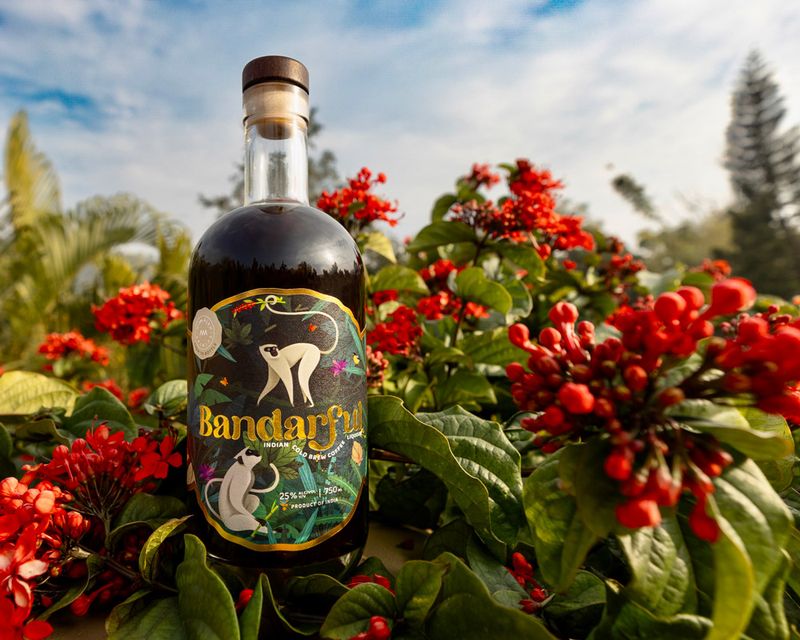
Wine professional Bhisham Mansukhani, says the whole recent movement of new age producers of craft spirits is showing the veterans of the industry how modern-day marketing can be done. “Until 15-20 years ago, producers were not focused on the creative aspect and the presentation of the alcohol. Artists would have even had their reservations of collaborating with Indian alcohol companies due their sheer commercial focus,” opines Mansukhani, adding, “In 2015, I attended a party Absolut’s creative competition where I saw some bottles with Rajasthani artists. That was disruptive.”
According to him, there has been a de-commodification of alcohol in the last 10 years. “Alcohol isn't just seen as a product that gets people intoxicated, but as part of an entire emerging social culture. So, the way it is styled is as important as the way it is produced. In recent times, Strangers and Sons paved the way for art to tell the story of the spirit,” he signs off.


_1714985780405_thumb_1200.jpeg?w=3840&q=75)